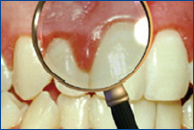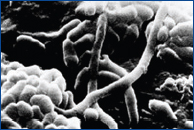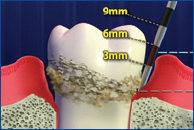Diagnosing periodontal disease
|
What is Periodontal Disease?
Periodontal disease is an infection of the teeth, gums, and the bone that surrounds the teeth, and it’s the leading cause of adult tooth loss. Stopping this condition begins with a thorough diagnosis. What Causes Periodontal Disease? The main cause of periodontal disease is the accumulation of plaque, the sticky film of food and bacteria that forms constantly on your teeth. If plaque isn’t removed each day, the bacteria in plaque invade the spaces between the teeth and gums and begin producing toxins. These toxins, combined with your body’s reaction to them, destroy the bone around your teeth. And once bone has been lost, it never grows back on its own. When too much bone is lost, there’s so little support for the teeth they get loose and have to be removed. |
The Warning Signs
If you have periodontal disease, you may be experiencing persistent bad breath, bleeding of the gums when brushing or flossing, soft, swollen, or tender gums, gums pulling away from the teeth, or lose teeth. You may also notice inflammation of the gums between the teeth. This is where periodontal disease usually starts. It is possible to have no noticeable symptoms. In fact, most people who have periodontal disease aren’t even aware of it. Diagnosis and Treatment To find periodontal disease, we perform a thorough examination with a periodontal probe and x-rays. Periodontal probing measures the depth of the space between your teeth and gums. When you have periodontal disease, these spaces are called pockets. We measure the pocket from the bottom of the pocket, where it’s attached to the tooth, to the top of the gums. A probe reading of more than three millimeters is a sign of periodontal disease. In general, the deeper the pockets, the greater the spread of periodontal disease. Gums sometimes bleed during probing. This is also a sign of infection. X-rays tell us a lot about periodontal disease. As periodontal disease progresses, x-rays will show that jawbone levels have become uneven, and that bone has receded away from the necks of the teeth. Once we have found periodontal disease, we’ll talk with you about treatment options and proper homecare to minimize bone loss and restore the health of your gums. |




